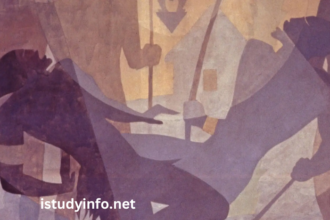The paintingAspects of Negro Life: Song of the Towers, created by artist Aaron Douglas, holds a profound place in the history of African American art. This artwork is a powerful representation of the Harlem Renaissance, a period that celebrated Black culture, art, and music. It conveys both the struggles and triumphs of African Americans through a vibrant, modernist lens.
Douglas’sAspects of Negro Life: Song of the Towers encapsulates the essence of the Black experience in America during the early 20th century. The striking composition uses symbolism to reflect the cultural, social, and economic realities faced by African Americans. Through this work, Douglas contributes to the artistic movement that highlighted racial pride and the need for social change.
What Inspired Aaron Douglas to Create Aspects of Negro Life: Song of the Towers?
Aaron Douglas, a key figure in the Harlem Renaissance, was inspired by the complex layers of African American identity and the changing social landscape of the time.Aspects of Negro Life: Song of the Towers was influenced by his commitment to portraying Black life in a way that combined modernism with African traditions. This artwork specifically reflects the period’s blend of optimism and resistance.
The use of bold forms and strong lines inAspects of Negro Life: Song of the Towers demonstrates Douglas’s desire to create a narrative that was both personal and political. As the Harlem Renaissance grew in prominence, African American artists sought to craft images that told their stories—stories that were often ignored or misrepresented by mainstream American culture. This painting stood as a visual anthem of empowerment.
How Does Aspects of Negro Life: Song of the Towers Reflect the Harlem Renaissance?
The Harlem Renaissance was a period of intellectual and cultural growth for African Americans, marked by a flourishing of art, literature, and music.Aspects of Negro Life: Song of the Towers embodies these themes through its integration of jazz and African American culture. The painting’s style, dynamic and abstract, mirrors the vibrant rhythms of jazz music that were central to the Harlem Renaissance.
In addition to its stylistic elements,Aspects of Negro Life: Song of the Towers serves as a visual tribute to the leaders, artists, and intellectuals who shaped this cultural movement. Through the towers and figures in the artwork, Douglas visually narrates the aspirations of Black Americans to rise above adversity and achieve cultural greatness. The work’s symbolism connects to the hopes and dreams of those involved in the Harlem Renaissance.
What Symbolism Can Be Found in Aspects of Negro Life: Song of the Towers?
Aspects of Negro Life: Song of the Towers is laden with symbolism that speaks to the African American experience. The towers in the artwork represent the possibilities of progress and achievement, drawing a connection to both the literal skyscrapers of Harlem and the metaphorical aspirations of Black Americans. The figures depicted in the painting also represent a collective strength, resilience, and unity within the African American community.
The dynamic imagery inAspects of Negro Life: Song of the Towers tells a story of overcoming hardship through determination and solidarity. The swirling patterns and interconnected forms reflect the interconnectedness of African American life and history. Through these visual metaphors, Douglas conveys a sense of upward mobility and cultural pride, which was central to the Harlem Renaissance ethos.
What Is the Historical Context of Aspects of Negro Life: Song of the Towers?
Created in 1934,Aspects of Negro Life: Song of the Towers was produced during a time of social and economic change in America. The Great Depression had left many African Americans struggling, yet the Harlem Renaissance was still in full swing, and there was a sense of optimism in the arts. The work reflects this paradox, highlighting both the challenges faced by African Americans and the vibrancy of their cultural expression.
Douglas’s painting, a part of a larger series, reflects the deep political and cultural shifts happening during this period. The image speaks to the resilience of the African American community and the continuous fight for equality. The history of racial oppression is woven into the fabric of the artwork, yet there is also an undeniable message of hope and pride for African Americans during this era.
How Did Aspects of Negro Life: Song of the Towers Influence African American Art?
Aspects of Negro Life: Song of the Towers had a significant influence on the direction of African American art. Its unique blend of modernist and African-inspired elements opened the door for future generations of Black artists to explore their own cultural identities through art. Douglas’s use of color, form, and symbolism set a precedent for how Black artists could represent their experiences and histories in a manner that was both deeply personal and universally relevant.
The work not only influenced visual artists but also inspired musicians and writers within the Harlem Renaissance.Aspects of Negro Life: Song of the Towers became a visual reflection of the aspirations of the entire movement, contributing to the reshaping of African American cultural expression. As a result, Douglas’s legacy endures as a foundational figure in the history of Black art.
Conclusion
Aspects of Negro Life: Song of the Towers remains a key symbol of African American history and culture, representing both the struggles and triumphs of the Black community. Through its rich symbolism, modernist style, and deep connections to the Harlem Renaissance, this artwork by Aaron Douglas continues to inspire discussions about race, identity, and the role of art in social change. The painting’s legacy highlights the powerful connection between art and culture, making it an enduring piece in the history of American art.















